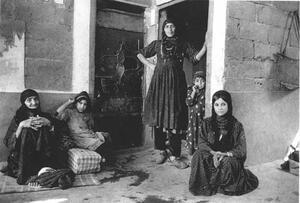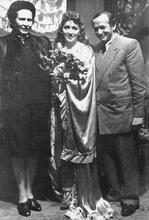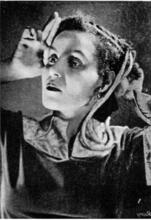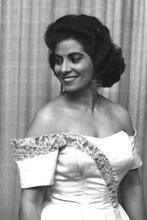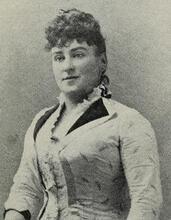Yemenite Women in Israel: 1948 to 2005
The transition of Yemenite women from a traditional religious society to a western-secular society upon immigration to Israel was marked by a certain ambivalence. Their status and gender roles changed, and they became integrated both economically and socially into Israeli society. However, the new values underwent a certain degree of filtration as Yemenite women accepted some elements while rejecting others. Yemen-born women found that moving to Israel put an end to some traditional symbols of femininity. Many Israeli-born Yemenite women see themselves as Israeli, their ethnic identity being only one, sometimes marginal, component of their identity. In all, they view their past through their current experiences and learn to accept and live with contradictory perceptions and realities.
Approximately 50,000 Jews came to Israel from Yemen via Operation Magic Carpet during the period of mass immigration (1949–1950) (Barer 1956; Sa’adon 2002: 115–125). A further 3,500 arrived between 1988 and 1996 (Saadon 2002, 122). The transition from a traditional religious society to one that was modern, primarily Western, and secular had a profound influence on the entire community and particularly on the women, whose familial and societal roles were profoundly affected.
The Early Immigration: Moshavim
After being housed in transit camps, many of the immigrants were directed to agricultural settlements (moshavim) (Zadok 1985; Lisak 1999). Their acclimation in these rural settlements proved difficult, due to both their lack of agricultural experience and their traditional social structure, which went counter to the principles of the Cooperative smallholder's village in Erez Israel combining some of the features of both cooperative and private farming.moshav. One focus of conflict was the status of the Yemenite woman and her gender roles, since moshav ideology advocated women’s full partnership in agricultural labor and social activity (Yaffe 1919: 20–21; Uri 1946: 26–30).
In Yemen, Jewish women did not participate in public life and their roles were restricted to childbearing and housekeeping. Authority and the ownership of property were in the hands of the men, and strict separation between the sexes was upheld (Razhabi 1988: 237–243; Druyan 1992). There was also a clear division of labor in the patriarchal family. Each spouse obtained support from his or her extended family in performing his or her duties and thus relied less on support and help from the spouse (Bott 1957). In contrast to this separation, in the moshav women demonstrated extensive business initiative, which was an important factor in changing the immigrants’ tradition. Concomitantly with the system of cooperative marketing that was controlled by the men, the women developed an informal economic system. They traveled into town, sold agricultural produce at high prices, and bought products for their homes. This activity afforded economic independence, increased their power in the home, and helped them develop social networks with women outside their communities. The women were thus more exposed to different values and lifestyles than the men. These changes demonstrate how immigration conditions expose women to new opportunities that serve as a source for their empowerment (Yung 1995; Kazum 2002).
Although their economic and social power increased, the Yemenite women were not motivated to achieve greater authority in their family or community. Formal power and authority continued to be monopolized by men in both the private and the public sphere (Katzir 1976; 1984).
Homogeneous Urban Settlements
Although processes of change occurred in the status of women and in family life in settlements of immigrants from Yemen, ethnic homogeneity slowed the rate of such change and contributed to the preservation of tradition (Nussbaum 1986, Cohen 1994).
Though there was a general tendency to preserve ethnic customs, they were not preserved in their original form: it is impossible to miss workdays in order to hold week-long premarital marriage celebrations, as was the custom in Yemen (Kalfa 2002, 158–212). The celebrations were therefore reduced to one evening, devoted to the hinnah ceremony (when the bride’s hands and feet are dyed), which is still conducted according to Yemenite tradition. However, Israeli elements gradually changed this ceremony, for example by abolishing the separation between the sexes. Such changes indicate that even a traditional society undergoes processes of change (Katz 1960).
Since the men had difficulties in providing for their families, women worked as household help outside their settlement. Their income was usually equal to that of their husbands and sometimes they were even the main wage earners. They were also the first to come into contact with a different culture and were willing to adjust to social changes. This situation undermined family relations since the authority of the father decreased, whereas the woman’s status changed dramatically as she succeeded in coping with the new reality better than the man (Soen et al. 1980).
Women’s organizations that operated after the establishment of the settlements strengthened women’s status through courses and lectures. While many women participate in these activities, they sometimes feel frustrated and do not identify with messages of “women’s liberation,” which are still foreign to their cultural world.
Heterogeneous Urban Settlements
Life in mixed communities provided Yemenite women with flexibility in their lifestyle, since they were under less social supervision (Gilad 1989; Lewis 1994). Although they still maintained traditional patterns of thought concerning gender roles, there were new ways in which women could behave while still perceiving these ways as part of woman’s varied roles. The decline in their husbands’ status and in their economic earning activity transferred the primary authority over the children to the women. They became active even in the field most characteristic of a man’s status in Yemen—religion—and participated in Bible classes and seminars.
For most of them parenthood involves considerable frustration, since the home sphere is no longer a haven from society. The situation is compounded by their ambivalent feelings towards their roles: while they do not wish to be “primitive,” as they were in Yemen, they are also unwilling to surrender authority over their children or accept a new definition of sexual codes. If they wish to impose the rules practiced in Yemen on their daughters, they are compelled to be flexible. They are aware of aspects of modern life in Israel, especially those that afford equal opportunities to women (Yishai 1996), and they are proud of their daughters’ achievements: good education, military service, and the acquisition of a profession. They understand that their children have become an integral part of society and their desire is that their children will not have to overcome difficulties such as they themselves encountered as immigrants. However, the parents pay a heavy price, since many of the children no longer accept their authority and do not regard Yemenite tradition as an integral part of their identity.
Women Born in Yemen
The transition from an extended family to a nuclear family generated a significant change in the women who emigrated from Yemen during the 1950s. They came into contact with public institutions such as the baby-care center, kindergarten, and school, and through them became acquainted with a new social order. Their legal status also changed; they are partners in family property, polygamy is forbidden, and their consent is required for divorce (Teri 2000).
Changes already occurred in the perceptions and behavior of the women immigrants during their early Hebrew lessons in the absorption centers (Peretz-Amzalek 1998). Married women accepted new roles but remained committed to traditional values. Single women, who were prepared to undergo a profound change in their lives and neglect their traditional roles, indeed underwent such a change in their cultural identity, as well as in their social identity (Fitzgerald 1974). For example, they also studied outside the absorption centers, worked as office clerks and in education, as teachers. In addition, they changed their names to ones more common among women in Israel.
As Yemenite women began working outside the home, they became a central economic factor in the family, learned the concepts of Israeli society, and served as agents of socialization for their families. In contrast to the situation in Yemen, they also chose the women which whom they spent her free time, who became their “fictitious” relatives (Gilad 1989). The numerous social activities in which they could participate strengthened their self-esteem and increased their independence (Avraham and Sherni 1976). However, their new responsibility for supporting their families does not relieve them of responsibility for the housework and care of children. Thus they enters the “public sphere,” but their husbands do not enter the “private sphere” and they find themselves doing a “double shift” of work (Hochschild 1990, 4). Hard work and coping with a strange environment put an end to some of the traditional symbols that expressed their femininity: embroidered clothes, jewelry, cosmetics and ornaments made of Yemenite perfumed herbs (Sulami 2000). Their past in Yemen also has a significant effect on their perceptions and problems in Israel. On the one hand they recognize the restrictive way in which they were brought up. On the other, they view themselves as dispensers of moral values and proper conduct and expect their daughters to behave accordingly.
This conflict also affects the older women, who grew up in a society that respected the elderly (Razhabi 2000) but now feel looked down upon by society. Adopting a strategy of activity, mainly such as is related to their continued roles, helps them cope with problems of survival. The club for the elderly affords an alternative world and gives meaning and content to their lives. Their strong religious faith also helps them cope with hardships (Cohen 1994).
Israeli-Born Women
The Israeli-born daughters actively participate in the formal institutions of Israeli youth and in the main areas of Israeli society and thus actually complete their parents’ immigration process (Gilad 1989). At school these girls learn that they can rely on their talents and can realize them—a process that increases their self-confidence (Avraham and Sharni 1976). Most complete their high-school studies, with the encouragement of their home and ethnic environment.
Many of the Israeli-born women regard themselves as Israeli, their ethnic identity being only one, sometimes marginal, component of their identity. They are usually proud of their heritage and participate in some of the traditional ceremonies, although they do not always attribute to them the significance which they had in Yemen. Perceiving themselves as “modern,” they appreciate their parents but have reservations concerning their “primitive” lifestyle, which is inappropriate for the new conditions (Gamliel 1989, 200). Since their attitude towards past experiences is different, they do not face the dilemmas faced by their parents and their behavior patterns stem from the standards and expectations of Israeli society. Thus the gap created between these women and their parents is not only generational but also cultural (Gilad 1989).
Many of the Yemenite youth are not religious, but neither are they completely cut off from religion. The percentage of young people who define themselves as religious is high compared to other youngsters in Israel and many of them even define themselves as traditional (Herman 1979; Shoked 1984). We may thus conclude that there is no “abolishing religious symbols” (Deshen 1977) among the children born in Israel to Yemenite families, but rather a process of “forsaking religious symbols,” which is a more moderate form of abandoning religious values.
The Contribution of Yemenite Artists
Yemenite women’s creativity in the arts, especially in dance and music, has contributed greatly to the formation of Israeli culture. Yemenite folklore groups began to form in the 1950s (Bahat and Bahat 1989), the best-known being the Inbal dance theater, founded in 1949 by Sara Levi-Tanai, who was born in Israel to immigrants from Yemen but from an early age received a European education. She worked as a kindergarten teacher on A voluntary collective community, mainly agricultural, in which there is no private wealth and which is responsible for all the needs of its members and their families.Kibbutz Ramat ha-Kovesh and wrote popular songs for young children (Sara Levi-Tanai 2000; Shlomit Tanai 2000). Her creations as a poet, composer, and choreographer combined western tradition with her Yemenite heritage. At Inbal she developed a modern dance theater that integrates elements of ethnic movement, music, and clothing. However, in contradistinction to Yemen, boys and girls danced together. Her works deal with female figures from the Bible and with the lives of women in Yemen (Manor 1983; 2000). Rather than reconstruct the past, she drew material from it to serve as a foundation for something new: through the encounter between different cultures, she created an original Israeli dance. In 1973 she was awarded the Israel Prize for her life’s work.
Today one cannot talk about Israeli music without mentioning Yemenite singers (Flem 1998). From the 1950s to the 1980s they were integrated into the dominant culture and performed Western material. The most prominent example of such integration is Shoshana Damari, who received the Israel Prize in 1998. However, since the 1980s Yemenite women singers have returned to their origins and are trying to create a unique style, integrating old and new. Ofra Haza, who presented Yemenite music with ethnic dress and jewelry and western instruments, achieved international acclaim as a western pop singer presenting the “eastern” spirit. Achinoam Nini, who grew up in New York and began appearing in Israel during the 1990s, also succeeded in developing an international career. In her musical performances she integrates various styles from the Yemenite, Hebrew and international repertoire and aims at being accepted as an equal in the pop culture of Israel and the world.
Conclusions
The transition of Yemenite women from a traditional-religious society to a western-secular society is marked by a certain ambivalence. A change occurred in their status and in their gender roles and they became integrated both economically and socially. However, the new values underwent a certain degree of filtration as they accepted some elements while rejecting others. They view their past through their current experiences and learn to accept and live with contradictory perceptions and realities.
A process of syncretism has developed for them, with a mixing of different cultural traditions (Sharaby 2002, 17–22; Shaw and Stewart 1994). In this process the traditional groups do not relinquish their cultural identity, and the old, rather than disintegrating, is integrated into the new. This process expresses an ethnic minority’s agreement with—but also objection to—the dominant society and helps preserve its ancient traditions.
The significant contributions of Yemenite women to Israeli society also demonstrate the syncretic model, according to which the process of adopting the foreign normative system occurs mainly among the minority group. At the same time, all the interacting groups, including the absorbing society, change their values.
Hebrew
Avraham, Ada, and Shoshana Serni. “Women of Moroccan origin versus women of Yemenite origin: focused comparison on the subject of self.” Megamot 24 (1976): 424–448.
Bahat, Naomi, and Bahat, Avner. “The music and dance of Yemenite Jews in Israel: one hundred years of activity and research.” In Go, Dove: The Yemenite Jews in Israel, edited by Shalom Seri, 415–438. Tel Aviv: 1983.
Barer, Shlomo. On Eagles’ Wings. Tel Aviv: 1956.
Cohen, Orly. “Aspects of Existence in the World of Elderly Women from Yemen.” MA Thesis. Ramat Gan: 1994.
Deshen, Shlomo. “Concepts in the research of religious change.” In The Generation of Change, edited by Moshe Shoked and Shlomo Deshen, 43–54. Jerusalem: 1977.
Flam, Gila. “The contribution of female singers from the community of Yemenite Jews to Israeli song.” Tehuda 18 (1998): 90–94.
Gamliel, Haim. “Change and continuity in the family relations among the Jews from Yemen in Israel.” In The Ways of Yemen, edited by Sa’adia Gamliel et al. 188–201. Jerusalem: 1984.
Kapach, Joseph. The Ways of Yemen. Jerusalem: 2002.
Katz, Jacob. “Traditional society and modern society.” Megamot 10 (1960): 304–311.
Katzir, Yael. “Women from Yemen as agents of change in the workers’ settlement.” In The Jews of the Orient, edited by Shlomo Deshen and Moshe Shoked, 221–230. Tel Aviv: 1984.
Kazum, Aziza. “To become a minority, to examine gender: Jewish Iraqi women in the 1950s.” In Orientals in Israel, edited by Hanan Hever et al 212–243. Jerusalem: 2002.
Lisak, Moshe. The Great Immigration during the 1950s: the Failure of the Melting Pot. Jerusalem: 1999.
Manor, Giyora. “Inbal and Yemenite Dance in Israel.” In Go, Dove: The Yemenite Jews in Israel, edited by Shalom Seri, 399–414. Tel Aviv: 1983.
Idem. “Women in the Choreography of Sarah Levi Tanai.” In The Yemenite Woman, edited by Shalom Seri, 359–364. Tel Aviv: 2000.
Nussbaum, Sara. “Continuity and Change in a Yemenite Village (Rosh Ha’ayin).” MA Thesis. Ramat Gan: 1986.
Peretz-Amzaleg, Dalia. “He Is Like A Woman; He Does Not Know Anything.” MA Thesis. Tel Aviv: 1998.
Razhabi, Yehuda. “The status of the Yemenite woman in the Diaspora and in Israel.” Afikim 123–124 (2003): 35.
Idem. In the Circles of Yemen. Tel Aviv: 1978.
Saadon, Haim, ed. Yemen. Jerusalem: 2002.
Sharaby, Rachel. Syncretism and Adjustment: The Encounter between a Traditional Community and a Socialist Community. Tel Aviv: 2002.
Shoked, Moshe. “Commandments versus tradition: trends in the religiousness of the Oriental communities.” Megamot 28 (1984): 250–264.
Sulami, Tuvia. “Changes in the image of the Yemenite woman in poetry.” In The Yemenite Woman, edited by Shalom Seri 205–214. Tel Aviv: 2000.
Tanai, Sarah Levi. “The pioneers of Yemenite dance in Israel.” In The Yemenite Woman, edited by Shalom Seri, 415–438. Tel Aviv: 2000.
Tanai, Shlomit. “Sarah’s Life.” In The Yemenite Woman, edited by Shalom Seri, 339–350. Tel Aviv: 2000.
Teri, Ora. “Changes in the status of the Yemenite woman upon her immigration to Israel.” In The Yemenite Woman, edited by Shalom Seri, 311–322. Tel Aviv: 2000.
Uri, Jacob. Our Way. Tel Aviv: 1946.
Yaffe, Eliezer. The Founding of the Workers’ Settlements. Jaffa: 1919.
Yishai, Yael. “Myth and reality in equality between the sexes: Women’s status in Israel.” In Israel towards the Twenty-first Century, edited by Moshe Lisak and Baruch Kenny-Paz, 103–129. Jerusalem: 1996.
Zadok, Haim. The Burden of Yemen 1946–1951. Tel Aviv: 1985.
English
Bott, Elizabeth. Family and Social Network. London: 1957.
Druyan, Nitza. “Yemenite Jewish women: between tradition and change.” In Pioneers and Homemakers, edited by Deborah Bernstein. New York: 1992.
Fitzgerald, J. K., ed. Social and Cultural Identity. Atlanta: 1974.
Gilad, Lisa. Ginger and Salt: Yemenite Jewish Women in an Israeli Town. Boulder, San Francisco and London: 1989.
Herman, S. N. Israelis and Jews: The Continuity of an Identity. New York: 1970.
Hochschild, Arlie and Machung, Anne. The Second Shift. New York: 1990.
Katzir, Yael. The Effects of Resettlement on the Status and Role of Yemeni Jewish Women: The Case of Ramat Oranim, Israel. Ph.D. Diss., Berkeley: 1976.
Lewis, Herbert. After the Eagles Landed: The Yemenite of Israel. Illinois: 1994.
Soen, Dan, Yona Haivi, and Dhalia Pal. “Cultural confrontation of six families originating from the Yemen with Israeli reality and its effects on their social adjustment.” ITCC Review 4/36 (1980): 34–44.
Stewart, Charles, and Shaw, Rosalind (eds.). Syncretism/Anti-Syncretism. London: 1994.
Yung, Judy. Unbound Feet: A Social History of Chinese Women in San Francisco. Berkeley: 1995.

